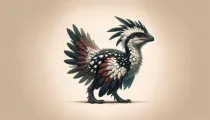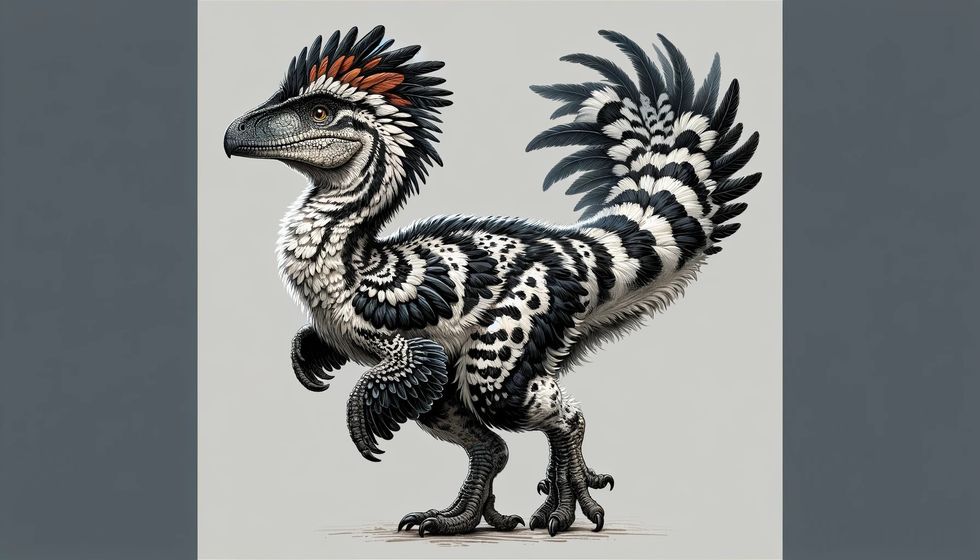The Anchiornis was a bird with relatively short primary feathers and long wing feathers. The bird's extensive leg and hind wing feathers hinted at some level of flying ability. This bird's most intriguing and unique feature was its long hind wing feathers, which gave it a four-winged appearance.
These birds of prehistory sported primary feather coverts that extended on both fore and hind wings, with the longest wing feathers perhaps facilitating a gliding or flying ability, albeit in a limited manner, unlike many modern birds.
Anchiornis Interesting Facts

How do you pronounce 'Anchiornis'?
It's pronounced as 'Anki-OR-nis'.
What type of dinosaur was it?
It was a small, feathered maniraptoran dinosaur closely related to the lineage that led to modern birds.
In which geological period did this dinosaur roam the Earth?
It lived around 160 million years ago during the Oxfordian stage of the Late Jurassic Period(163.5-145 million years ago).
When did the Anchiornis become extinct?
It went extinct around 160 million years ago, with all known fossils discovered in the Tiaojishan Formation of Liaoning, China, from the Late Jurassic Period.
Where did this dinosaur live?

It lived in what is now northeastern China.
What was their habitat?
Their habitat was primarily forested areas, often found near bodies of water.
Who did they live with?
During the Late Jurassic Period in present-day northeastern China, the Anchiornis huxleyi lived alongside small feathered dinosaurs like Eosinopteryx and Tianyulong, as well as diverse pterosaurs such as Darwinopterus.
They shared habitats, suggesting diverse evolutionary paths to flight and occupied different roles within a vibrant forest ecosystem.
How long did this dinosaur live?
The lifespan of Anchiornis is not known. Continued research may provide more information on its lifespan.
How did they reproduce?
Anchiornis huxleyi, a small feathered dinosaur that lived about 160 million years ago, was an oviparous species, which means that it reproduced by laying eggs.
This process of reproduction involves the female laying eggs that are fertilized by a male, either before or after they are laid.
Oviparity is a common mode of reproduction among many species of reptiles, birds, and some species of mammals.
In the case of Anchiornis huxleyi, the eggs were laid in nests and incubated until they hatched, giving rise to a new generation of these fascinating creatures.
Anchiornis Fun Facts
What did they look like?
The Anchiornis huxleyi, akin to a crow in size, was a small feathered dinosaur from the Late Jurassic Period.
It sported both downy and vaned feathers across its body, with lengthy feathers on its arms and legs, creating a four-winged profile that may have allowed for gliding.
The feathers were mainly black and gray with white stripes and a red crest, while parts of the body had scales.
How many bones did an Anchiornis have?

The exact number of bones in Anchiornis is unknown, but their skeletons were similar to birds with light-ness adaptations.
How did they communicate?
Anchiornis, a feathered dinosaur species that lived during the Late Jurassic Period, had an interesting communication system.
Although there is little evidence to suggest how they communicated, some experts believe that they may have used visual displays of their feathers or sounds like many modern birds.
It's possible that Anchiornis used their brightly colored feathers to attract mates or intimidate rivals, just as many modern birds do. Alternatively, they may have used a combination of visual and auditory cues to communicate.
However, without more direct evidence, it is difficult to say for certain how Anchiornis communicated.
How big was the Anchiornis?
The Anchiornis huxleyi was a small dinosaur that stood at a height comparable to that of a chicken and measured a mere 1.1 ft (34 cm) in length.
Despite its small size, this fascinating creature remains a source of wonder and curiosity for dinosaur enthusiasts and scientists alike.
How fast could this dinosaur move?
While exact speeds are unknown, their leg structure suggests they were quick, adept runners, possibly with some gliding ability.
Ongoing research in the field may eventually reveal more about their movement.
How much did an Anchiornis weigh?
The holotype, which was a subadult or young adult, had a weight of 3.9 oz (110 g). The larger specimens weighed between 1.3–2.2 lb (0.6–1 kg).
What were the male and female names of the species?
Anchiornis, an extinct species of bird-like dinosaurs that lived in what is now China during the Late Jurassic Period, did not have specific names to differentiate between males and females.
In other words, both males and females of the species were simply referred to as Anchiornis.
This lack of gender-specific naming is not uncommon among extinct species, as it can be difficult to determine the sex of an individual from the fossil record alone.
What would you call a baby Anchiornis?

It's believed to have given birth to offspring that could be called nestlings, chicks, or hatchlings, just like the young of contemporary birds that are descendants of similar theropod dinosaurs.
These young Anchiornis likely had a fluffy appearance due to their downy feathers, and were probably quite helpless and reliant on their parents for survival.
This parallel between the young of Anchiornis and modern birds offers further evidence of the evolutionary link between these groups of animals.
How aggressive were they?
This dinosaur lived about 160 million years ago and is believed to have lived in a world full of competition and predators.
While it is uncertain how aggressive they were, they likely had to defend themselves against other species that competed for resources or even hunted them as prey.
This would have been a constant challenge for Anchiornis to survive and ensure their species' survival.
Did You know...
The Anchiornis, a feathered maniraptoran dinosaur fossil from the Late Jurassic Period, was a marvel to paleontologists due to its intricate feathering. Among its feather plumage coloration, this small but striking creature showcased predominantly black head feathers, featuring a reddish crown for a burst of vivid contrast.
The bird's shaggy coat, made of extensive leg feathers and grey and black body feathers, not only insulated but also gave insights into the evolutionary shift to modern birds.
Anchiornis, like all feathered dinosaurs, had origins in maniraptoran, and displayed traits found in both dromaeosaurs and troodontids.
As compared to later species such as Microraptor, the wings of Anchiornis were well-developed but relatively short, featuring primary feathers that were short and had rounded, symmetrical tips, unlike the aerodynamically proportioned feathers of Microraptor.
Long downy feathers covered a significant portion of its body, including the head, neck, torso, upper legs, and the first half of the tail. These details of the Anchiornis' plumage, reconstructed from well-preserved fossils, help scientists accurately portray this prehistoric bird-like dinosaur.
FAQs
What does the name of this dinosaur mean?
The name of this dinosaur, Anchiornis, means 'near bird', reflecting its position in the evolutionary tree close to the origin of birds.
Could this dinosaur fly?
It's not certain that this dinosaur could achieve powered flight like modern birds. However, its long feathers on both fore and hind limbs suggest it might have been capable of gliding between trees.
How do we know the color of this dinosaur's feathers?
Scientists have discovered microscopic structures in the feathers of this dinosaur that are known to contain pigments, allowing them to speculate on the coloration similar to birds today.
Did this dinosaur have a beak?
This dinosaur did not have a true beak; instead, it had a mouth with teeth, which is typical for theropod dinosaurs from which birds evolved.
What can this dinosaur's feathers tell us about its behavior?
The extensive feather coverage, including wings and hind limbs, suggests that it may have used its feathers for display and communication, in addition to any potential aerial locomotion.
What did this dinosaur's ecosystem look like?
This dinosaur inhabited lush, forested environments with dense vegetation, ideal for an arboreal lifestyle and conducive to the variety of prey and plant life it may have consumed.
Are there any living descendants of this dinosaur?
This dinosaur is part of the evolutionary lineage of theropods leading to birds, so all modern birds could be considered its distant descendants.
How significant are the fossils of this dinosaur to science?
This dinosaur's fossils are incredibly valuable as they provide a clear snapshot of the transition between feathered dinosaurs and the first birds, filling an important gap in our understanding of evolutionary biology.
How did this dinosaur interact with its environment?
With limbs adapted for climbing and potentially gliding, it likely navigated through the forest canopy, aiding in hunting and perhaps evading predators.
What challenges does this dinosaur's preservation pose for scientists?
Ensuring the preservation of delicate structures like feathers requires careful excavation and storage conditions, as well as advanced imaging techniques to study microstructures without damaging the fossils.
Anchiornis stands out among dinosaur discoveries for its extensive and well-preserved plumage, giving scientists an invaluable insight into the evolution of feathers and the early stages of flight.
This exceptional dinosaur, with its detailed feather structure and evidence of vibrant plumage, highlights the awe-inspiring complexity of life on Earth and the evolutionary kinship between dinosaurs and birds.
Related Articles Around the Web













